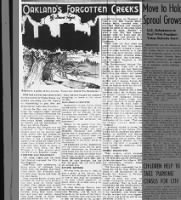Oakland's Forgotten Creeks
(Second in a series of five articles. Tomorrow - Maybe You Remember.)
Gold had not yet been discovered, but the hamlet of Yerba Buena was already assuming city-like dignity by repudiating its goat feed and adopting the name San Francisco.
Across the Bay was the Contra Costa, the "opposite coast," destined in less than a century to become the huge industrial and residential center of Metropolitan Oakland, but then virgin forest, inhabited only by Indians and the descendants of Don Luis Maria Peralta.
His Rancho San Antonio was the hinterland to San Francisco 40 leagues away by the shortest land route, within view but isolated by the wide expanse of often turbulent Bay. It had a background of gigantic trees along the ridges which sloped down through forests of live oaks and open fields of grass to the mud flats along the Bay. Through it in their pristine glory ran the 21 now forgotten creeks.
NURTURE SAN FRANCISCO
Yet, those creeks and the lands they drained nurtured the City of San Francisco.
They had their headwaters in dense groves of redwoods from which came the lumber that three times rebuilt San Francisco after fire had swept shacks and tents off the sand dunes.
They watered forests of oaks that enriched the land for grain production, lush grass on which cattle fattened. They teemed with salmon and trout, and their outlets to the Bay were over expansive beds of shellfish. Along their banks were deer and quail and rabbits, above them huge flocks of ducks and geese blackened out the sun.
They fed and housed the pioneers struggling to create a city across the Bay.
HAZARDOUS VENTURE
Exploration of the Contra Costa moved slowly in early days. It was effectively discouraged by the commandant of the Presidio of San Francisco who declared: "The country is almost unknown, the natives perverse, and the adventure too hazardous."
Efforts of the padres from San Jose Mission to bring religion to the "perverse natives." met such stubborn resistance that armed guards had to accompany them for their protection. One of these was Sergeant Peralta, assigned in 1798 to command of the king's forces at the mission.
He conducted several expeditions into the Contra Costa and the great natural advantages he discovered there made him the first to covet its ownership. He could not foresee what the Gringo would do to those lands, would undoubtedly have been saddened by such foresight, but the fish, the game, the rich cattle feed, all enticed him.
ESTATE DIVIDED
Retiring from service in 1820, he won a grant of the Rancho San Antonio, and although he continued to live at San Jose, he considered it his most valued possession, an estate which he divided among his four sons in 1842.
To Jose Domingo Peralta went the Northern section, which has become Berkeley, and he built his hacienda on the banks of the Codornices. Vincente, who was to be first to feel the inroads of the Gringo, erected his home on Temescal, at what is now 5521 Vicente Street. Antonio Maria, awarded what is now East Oakland and Alameda, placed his adobe on the creek which assumed his name, "Peralta," at what is now 2511 34th Avenue. Ygnacio built his home near San Leandro Creek and portions of it still stand as part of the Alta Mira Clubhouse.
Those were the days when the creeks received their first names. Some were later changed to correspond to street locations, or to take identity from early families. Others still remain today, retaining Indian or Spanish origin. But with meanings as nearly forgotten as the creeks themselves.
The Northernmost became Cerrito, from the "bald hill" at its mouth. Antonio and Jose Domingo feasted on quail eggs while hunting deer along one stream, and named it, for the quail Codornices. Someone killed a mountain lion near another and it became Arroyo del Leon, now Lion Creek. Sausal is from the Spanish word for the willow groves along its banks.
Euphonious Temescal had a most mundane origin. On its banks, near the present junction of Claremont Avenue with Telegraph Avenue, was a large Indian village, with one solid structure of sturdy poles. made air-tight by thick slabs of mud. In it some 50 Indians danced around a roaring fire until nearly dead from heat and their exertions. when the door was opened and the exhausted patients of primitive medicine allowed to dive into the cold waters of the creek. That was the Indian sweat house the "temescal."
It probably helped to hasten the disappearance of the Indians. They lived a life of indolence and plenty, feeding on shellfish and leaving mounds of shells to testify to their gourmanderie, and on acorns. Their constant digging beneath the oak trees for the latter is supposed to have earned the American nickname, "Diggers."
TRIBES DECIMATED
Their ferocity, which alarmed explorers, seems to have evaporated as the Spaniards gained ascendancy, cholera decimated the tribes in 1833, and pneumonia virtually wiped them out in the 50's.
The Spaniards superseded the Indians, but not for long. Within five years of the distribution of the Rancho San Antonio to Peralta's sons, the Gringo came.
First he took fish from the creeks, killed game animals, slaughtered wildfowl.
Then he built saw mills along the San Antonio estuary and
felled the redwoods. The discovery of gold gave sudden impetus to his operations, and before Don
Vicente realized what was happening, a city was growing and he was powerless
to stop it.
 Oakland's Forgotten Creeks #2 29 Jan 1947, Wed
Oakland Tribune (Oakland, California) Newspapers.com
Oakland's Forgotten Creeks #2 29 Jan 1947, Wed
Oakland Tribune (Oakland, California) Newspapers.com
.jpg)
Comments
Post a Comment